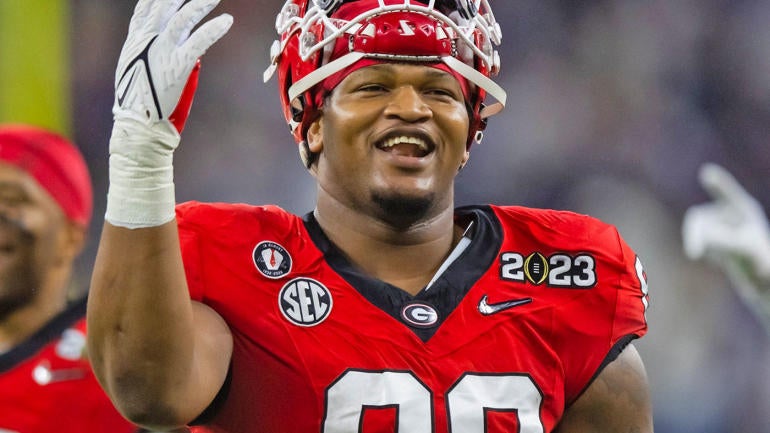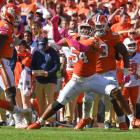
KANSAS CITY, Mo. - Jalen Carter is not much of a talker but his statement made last November still echoes all the way from Georgia's Sanford Stadium to this week of the NFL Draft. In a showdown against Tennessee while rushing the passer, the Dawgs' All-American defensive lineman swung his massive left arm violently enough to dislodge the ball from Hendon Hooker's throwing hand.
The Tennessee quarterback's fumble in the end zone somehow avoided resulting in a safety. The ball was spotted just outside the Vols' end zone. Nonetheless, the play set up the Dawgs for a short-field touchdown that broke open what was eventually a 27-13 victory.
In a flash, Carter had changed the game, his season and maybe his career.
The NFL Draft comes to Kansas City this week, itself a changed event. Not so much in the hoopla and hype - hey, who ever gets tired of a Motley Crue concert? - but in structure. Carter is the highest-rated defensive lineman in the draft, a possible top-five pick. Pro Football Focus had him as its highest-rated Power Five defender, the best defender on the sport's best defense two years in a row.
Never mind that Carter made only nine starts in 2022 because of injuries, that sort of designation comes with Pro Bowl projection and immediate defensive impact.
"I don't know if there is a position I value more than the inside guys on the D-line," Michigan defensive coordinator Jesse Minter said. "They give you so much flexibility. Their ability to not only take on blocks but to get off blocks and make tackles [are the difference]."
Carter has company lately in the draft. Since 2019 a total of 10 interior defensive linemen have been taken in the top 28. Six alone in 2019. That was more than the number of quarterbacks (five) taken in the first three rounds that year.
The 10 don't represent the most at any position but in those four years that total is more than all the running backs, centers and tight ends combined.
The position hasn't changed as much as the humans playing it have. They're certainly more valuable because they can do more. They're more nimble, more athletic than in the past. Remember, Alabama's Terrence "Mount" Cody? He played on Nick Saban's first national championship team in 2009.
"He could wreck a game," said Ted Lambrinides, a sports science consultant who has worked with the NFL and MLB. "The problem was he couldn't stay on the field."
Not for long enough -- Cody's NFL career lasted five years -- at an oxygen-sucking 345 pounds. Strategically, an inside defensive lineman today who can occupy two blockers and collapse a pocket is considered invaluable. Think of a lither athlete like the 6-foot-4, 313-pound Ndamukong Suh who came out the same year as Cody but lasted NFL 13 seasons.
"You don't win championships getting gashed up the middle," said Michigan defensive tackle Mazi Smith, a top 50 draft prospect per CBSSports.com.
"If the middle is weak, it's hard to defend. I'm not saying you rely on one person to stuff the middle, but if you get runs going
downhill over and over again, you get those guys in the secondary getting hurt."
From there, that sets in motion a numbers game. A dominant interior lineman makes it more likely an edge rusher can get home. That also relieves the pressure on a defensive coordinator who doesn't have to commit an extra body to the box to stop the run.
"We have a saying, 'Two on me, one is free,' Carter explained. "If I have two guys on me, there's another d-lineman or a linebacker who can come in and make a play."
Still to be determined is whether Carter's legal situation impacts his draft position. Carter pleaded guilty to reckless driving and racing in March. Police alleged Carter was in an SUV that was racing a vehicle containing Georgia player Devin Willock and a recruiting staffer. Willock and the staffer died in an accident that night.
The Rams' Aaron Donald may have refined this current trend of athletic, impactful defensive linemen. The nine-year veteran is making $28.5 million a year. But he has competition. Houston's Ed Oliver has become an established star at Buffalo. The same for Kansas City's Chris Jones. Slowed by injuries as a rookie, Georgia's Jordan Davis still made the NFL All-Defensive Rookie team.
"What Jordan Davis did for Georgia two years ago, he changed the game. He wrecked the game plan," Lambrinides said.
In 2021, Davis won the Outland Trophy (best interior lineman) and Bednarik Award (best defensive player) at 6-foot-6, 340 pounds. He statistics were predictably modest - 32 tackles, 5.5 tackles for loss and 2.0 sacks.
"They can make one or two plays a game," said TCU center Steve Avila. "I feel that's what a lot of people look at, when in reality there have been times when Aaron Donald has been blocked. I give praise to the offensive line. It's not easy at all what we do. It's not easy at all winning a one-on-one."
The physical characteristics of the position have changed so much that impact interior defensive linemen tend to be paid a lot for doing very little - at least statistically. They are no longer 300-pound slugs big enough to take on two blockers. A good day for Carter can include a forced fumble, a pass broken up and a few tackles.
They have to be sprightly chess pieces able to rule the A and B gaps. The A gap is the space either side of the center. The outside space of each guard is the B gap.
"If you have good interior defensive linemen, moreso than edge rushers, you're going to win in football," Nebraska coach Matt Rhule said. "You can play any defense you want. It's not about sacks. It's about the quarterback having to throw off [schedule] because there is someone at their feet."
"All quarterbacks are affected by what we call the pressure-in-the-pain area right in front of the quarterback," Rhule added. "We talk about speed rushers and power rushers, but a good quarterback can just step up.
"It's about the ability to have guys on the inside who can win one-on-one or push the pocket."
Five defensive tackles have won the Outland since 2009. They are, by now, close to being household names. Suh (Nebraska, 2009), Donald (Pittsburgh, 2013), Oliver (Houston, 2017), Quinnen Williams (Alabama, 2018) and Davis all were drafted in the first round. They will make more than $50 million combined next season, not counting Suh who is a free agent.
"They set the point for the defense ... If you find big athletic guys who can move like that but also are strong enough you can't knock them off the ball, it's a unique combination," said Will Rogers, Will Anderson Jr.'s high school defensive coordinator.
Anderson is expected to go high this week as an edge rusher, leaving a legacy as one of Alabama's best-ever defenders. Rogers played him inside briefly in high school.
"They're hard to find in the NFL. They're hard to find in recruiting," Alabama defensive coordinator Kevin Steele said of interior linemen. "High school coaches - I have tons of friends there - they're hard to find there."
The best stay home. It's no secret the Southeastern U.S. produces defensive tackles like Brazil produces soccer strikers or Bulgaria produces weightlifters. Ten of the last 14 defensive tackles taken in the top 47 picks since 2019 have been from either SEC schools or Clemson. Four of the top 8 schools in total defensive tackles taken are SEC programs - 1. Alabama (33 all-time); 2. LSU (30); T-4. Florida (27) and 8. Texas A&M (24).
"There's more of them [quality interior linemen] but it's hard to find people who can play 50-60-70 plays in a game," Steele said. "With 300 pounds on their right ear and 300 pounds on their left ear, that's 600 pounds every play."
Physiology indeed tells you these giants can't play every down. It has become a fine art for coaches figuring out rotations to keep their linemen fresh. The best teams are able to have eight or so quality lineman ready to go.
"The most exerting thing you do as a football player is rush the passer," Georgia co-defensive coordinator Will Muschamp said. "When big guys, in my experience, run out of gas, they're done. There's nothing left."
That's why Muschamp limits his linemen to no more than six consecutive snaps. The question has to be asked though as his best lineman reaches draft day: What is Carter's limit?
"Until Jalen gets tired," Muschamp said.





















